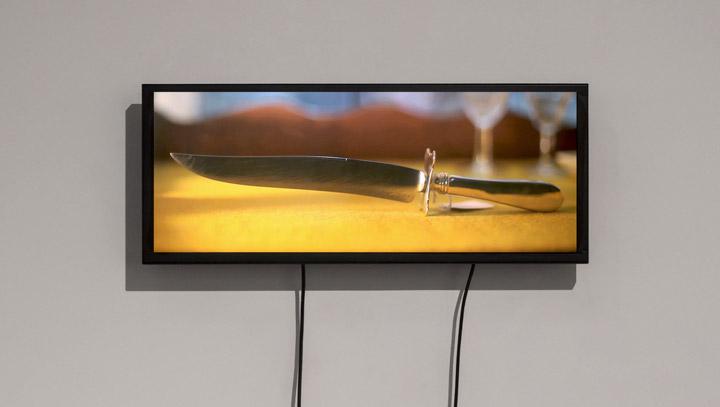In a recent Contact Photography Festival exhibition, Los Angeles–based Canadian artist Owen Kydd filled Toronto’s Brookfield Place with something of a perceptual dilemma. Installed on freestanding video kiosks interspersed throughout the soaring Santiago Calatrava–designed atrium were a selection of Kydd’s latest works. Things are perpetually in motion in the busy thoroughfare at the heart of the city’s financial district, but Kydd’s close-cropped studies of the leftover bric-a-brac found in partially disassembled storefront window displays were noticeably out of place. Not only did they conflict with the commerce-building preoccupations of a Bay Street hub, but for passersby accustomed to the frenetic hit of video-screen advertising, these images also seemed oddly static.
For those curious enough to stop and look, though, Kydd’s images did come alive in a deceptive play of reflected light and drifting motion—in one, a plastic palm tree offers a fractured mirror view of coursing street traffic; in another, a paper ornament and string subtly shift and turn on gentle gusts of wind. It’s an effect that is as poetic as it is pointed, revealing as much about how we perceive the world around us as it does about the value lost in the heedless momentum of modern life.
Vancouver art critic Aaron Peck looks further into Kydd’s ongoing study of “durational photography” in the cover story for our Summer 2014 issue of Canadian Art, which hits newsstands and the App Store on June 15. Here, Kydd introduces the material concerns and formative strategies behind a trio of recent video works, offering first-hand insight on what it means to look closely and think carefully.
Two-Way Polyester Flowers (2013)
“This is the same image ‘cut’ and reversed on top of itself, a sort of a play on cubism, but it might cancel the cubist impulse because it’s put back into time or duration. Plastic flowers match the materials I usually look for in my work; instead of organic forms, I search for the same types of matter that make up the cameras and video screens the work is made with and shown on.”
Knife (J.G.) (2011)
“Knife (J.G.) shows a found carving knife in a window. It’s a play on Jack Goldstein’s 1975 film The Knife where he raked coloured lights across a knife in his studio, though in this case, the headlights of passing cars do it. It’s possibly a found conceptual object? (i.e., an image that can only occur after the work of Goldstein or the Pictures Generation.)”
West Jefferson Wall (2013)
“Here we see a wall near my studio with materials as described above in a composition. It’s not so much abstract as it is looking at these pieces/materials in a more early Romantic way or in thinking about Hokusai Manga. It asks if this video system of display allows for that type of closely rendered study.”
All of these works by Owen Kydd are reproduced courtesy of Monte Clark Gallery. For more information about Kydd, make sure to pick up our Summer 2014 on bricks-and-mortar or digital newsstands from June 15 to September 14.

 Owen Kydd, Knife (J.G.), 2011, Video, 76.2 cm panoramic display. Courtesy Monte Clark Gallery/Nicelle Beauchene Gallery, New York.
Owen Kydd, Knife (J.G.), 2011, Video, 76.2 cm panoramic display. Courtesy Monte Clark Gallery/Nicelle Beauchene Gallery, New York.







